ARMA
Interview with Hank Reinhardt
August, 2001
Note: The following content does not
reflect official views
or opinions of either ARMA or its members.
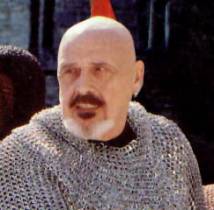
Julius
Hank Reinhardt, original founder and now Senior Advisor of ARMA, is one of the
world’s foremost authorities on sword history and use with more than 50 years
experience in Medieval reenactment, weaponry, practical research, and arms collecting. He was founder and former director of Museum
Replicas Ltd., and is now a consultant to the reproduction sword industry.
ARMA: Hello again. Recently, you were up in
Calgary to give a lecture at the Glenbow museum, and you attended the Atlanta Blade show
as well as some large Sci-Fi/Fantasy conventions, can you tell us anything interesting
about how they went?
Hank: “The trip to Calgary was particularly
interesting. The Glenbow Museum has a very nice collection, really interesting swords. I
hope Museum Replicas Limited can do reproductions of some of them in the near future. As
for the Blade Show and conventions, what becomes more and more obvious is the increased
interest in this whole field. The field is widening considerably. Not only those
interested in history, but fantasy, and now there is even a gaming element coming into the
sword field. I think it’s going to grow larger and larger. There are times when I
regret my age, thinking of the fun I could have if I were only 40 again. Oh well, Ewart
Oakeshott and I have talked about this in the past, so I have to be content with at least
having been in at the beginning. I was at WorldCon too recently but due to a sudden
illness was unable to do much.”
ARMA: And certainly being
an inspiration and guide to a whole other generation as well.
Hank: “My love of swords has led me into many
strange paths. By trade I was a safety engineer, and that’s what I did for most of my
working life. But the more I studied the
sword, the more curious I became on why certain things were so, and why it worked they way
it did. The end result was that I became interested in metallurgy, leather working,
woodworking, and even geometry. I had always had an interest in physics and history. Years
ago I was also fortunate in meeting, and becoming close friends, with one of the best
blacksmiths and knife makers in the country, Jimmy Fikes. Jim made some katana blades
whose cutting power is truly awesome. Jimmy himself can also cut better than anyone
I’ve ever seen. Part of the reason is that he is very quick, and also strong as a
gorilla. The combination leads to some impressive cutting.”
ARMA: So, tell us something of what went into
making your new video, The Myth of the Sword?
Hank: “The Myth of the Sword came
about as just a way to answer some of the more frequently asked questions. As we got
further into it we felt that it was necessary to show some of the power of the sword, and
some of its effects. It was lots of fun to do, and I hope it answers some questions.”
ARMA: You have plans for several other videos on
swords and swordplay. What can you tell us?
Hank: “The
next video is on the early Medieval sword, for all practical purposes Viking, Saxon,
French, look pretty much alike, and be handled the same way. The difference is more in
decoration that in shape. In the video we show some fights, with shields, without shields,
with and without armor.”
ARMA: You’ve been very, very busy since the
last time we interviewed you a few years back. The first thing that should be asked is,
although there’s now a great deal of discussion going on in the sword and historical
combat communities, you seem to never take part in it. You’re not on the Internet
much at all. Why is that?
Hank: “Two reasons. One is time. My forthcoming
book on swords and swordfighting is taking longer than I had thought it would, and I have
a lot of other commitments. The other is that I don’t find the Internet particularly
interesting or entertaining. More, time consuming.”
ARMA: You’ve
been at work on the book for over five years now. So,
you feel the Net is not interesting, why is that?
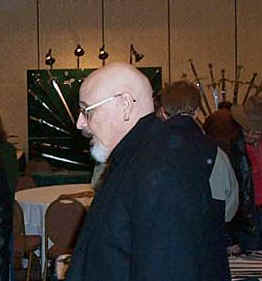 Hank: “Frankly, you have to wade through way too
much junk to find anything that’s worthwhile. I do check it out every now and then,
but I don’t feel the need to get involved. Let
me explain. The people I have met over the
years in the field of arms and armor consider themselves serious students. Ewart
Oakeshott, who, in my opinion, is still the most knowledgeable person alive in the study
of the European sword, also considers himself a serious student. No one considers
themselves absolute “experts”. To be real expert on all this you have to know
everything that there is to know about the subject, and that is simply not possible with
this. But since the Internet has arrived, there are tons of people who are passing
themselves off as experts. Experts in the history of the sword, the manufacture of the
sword, and of actually fighting with swords. In addition, with few exceptions I see very
little reasoned discourse or exchange of information. What I do see is innuendo, attacks,
rumors, and outright lies. If you have a
difference of opinion with someone, then you explain where and why you think he is in
error. Then it is his turn to reply. This allows for intelligent and reasoned discourse.
When that happens opinions are changed or reinforced. But from what I have seen on the
Internet, this doesn’t happen. When two people disagree, they immediately attack one
another, and start spreading rumors or putting out outright lies about each other. I am
just too old and ornery to put up with that nonsense, so I just don’t play.” Hank: “Frankly, you have to wade through way too
much junk to find anything that’s worthwhile. I do check it out every now and then,
but I don’t feel the need to get involved. Let
me explain. The people I have met over the
years in the field of arms and armor consider themselves serious students. Ewart
Oakeshott, who, in my opinion, is still the most knowledgeable person alive in the study
of the European sword, also considers himself a serious student. No one considers
themselves absolute “experts”. To be real expert on all this you have to know
everything that there is to know about the subject, and that is simply not possible with
this. But since the Internet has arrived, there are tons of people who are passing
themselves off as experts. Experts in the history of the sword, the manufacture of the
sword, and of actually fighting with swords. In addition, with few exceptions I see very
little reasoned discourse or exchange of information. What I do see is innuendo, attacks,
rumors, and outright lies. If you have a
difference of opinion with someone, then you explain where and why you think he is in
error. Then it is his turn to reply. This allows for intelligent and reasoned discourse.
When that happens opinions are changed or reinforced. But from what I have seen on the
Internet, this doesn’t happen. When two people disagree, they immediately attack one
another, and start spreading rumors or putting out outright lies about each other. I am
just too old and ornery to put up with that nonsense, so I just don’t play.”
ARMA:
The present climate is rather ugly with some of the slander and snubbing going on.
Differences of philosophy too easily slide into rivalries of ego, resentment and envy. Miscommunication seems to also be the norm on the
Net. It’s a shame. Some people can’t provide justifications or reputable sources
for their beliefs and opinions, so they get ugly instead.
Hank:
“I think that every person or group has a right to state whatever they wish, no
matter what others may think. In some areas I agree with every group out there, and I also
disagree in major areas with these same groups. I would be happy to state my opinions, and
would be willing to discuss it. But that doesn’t seem possible with the things I read
when I chance to look at some of the things on say, the Sword Forum or a few of the other
Internet sites. Everyone seems to forget the main reason we are all interested in swords,
weapons, and weapon play. For the sheer fun of it. We aren’t going into battle with
swords! But the main reason that I don’t
show a presence [on the net] is that I simply don’t like a lot of what goes on there. I’ll tell you, I consider myself a serious
student of arms and armor, with the greater portion being aimed at swords, and weapons in
general. I have been around this business for a long time, and have heard so much hype and
nonsense, and frankly, as I read further, I’m put off by all of it.”
ARMA: Your reasons for not bothering to respond
publicly makes sense.”
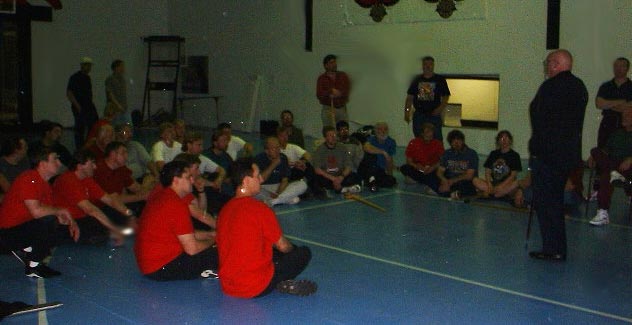 Hank: “Since the Internet began to play a
role in this subject, there have been hundreds of “sword experts” that have
crawled out of the woodwork. There are a few who seem to be dedicated scholars in the
field, and anxious to learn and share their knowledge. But the majority, by far, seems to
consist of people who wish to achieve some prominence by attacking other people. These
attacks frequently masquerade as mere “difference of opinion”, but when
examined, turn out to be nothing but slights on various individuals and groups.
There’s too many folk hiding behind their computer and their opinions have no affect
on me or my knowledge or my business. I
regard a few as “yipping Chihuahuas”. Did
you ever notice how these small, useless dogs are always yipping, trying to attract
attention? Well, some people on Internet forums have nothing to say, they’re barking
to attract attention.” Hank: “Since the Internet began to play a
role in this subject, there have been hundreds of “sword experts” that have
crawled out of the woodwork. There are a few who seem to be dedicated scholars in the
field, and anxious to learn and share their knowledge. But the majority, by far, seems to
consist of people who wish to achieve some prominence by attacking other people. These
attacks frequently masquerade as mere “difference of opinion”, but when
examined, turn out to be nothing but slights on various individuals and groups.
There’s too many folk hiding behind their computer and their opinions have no affect
on me or my knowledge or my business. I
regard a few as “yipping Chihuahuas”. Did
you ever notice how these small, useless dogs are always yipping, trying to attract
attention? Well, some people on Internet forums have nothing to say, they’re barking
to attract attention.”
ARMA: “Would
you care to elaborate on that any?
Hank:
Recently some comments were made that spurred me to want address issues that had been in
the back of my mind for some time. There were a few specific ones made by certain folk,
not worth mentioning, but they did contain a lot of misinformation, and some it was simply
absurd.
ARMA: There are some sword
fabricator’s now making claims about their machine-ground blades having special
“harmonic” qualities that differ them from other replicas. Any comments on such hype?
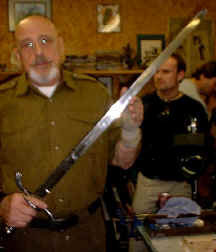 Hank: “This
is just the idea of the ‘sweet spot’ [or node] on a sword; it has gotten more
attention than it really deserves. The sweet spot on a sword is the small section where
you get the greatest amount of force [i.e., the preferred or optimal striking area], with
none of the force being wasted in vibration. However, the difference in cutting
effectiveness between the sweet spot and, say the last 2-3 inches of the sword, is very
small. I have done a great deal of cutting with all manner of swords, and I can cut mail,
flesh and bone just as well by using the end of the sword as by hitting with the sweet
spot [as seen at the Atlanta ARMA Expo, ed.]. You start losing some of the effectiveness
of the cut when you move closer to the hilt. You then get vibration, and the speed of the
sword is less.” Hank: “This
is just the idea of the ‘sweet spot’ [or node] on a sword; it has gotten more
attention than it really deserves. The sweet spot on a sword is the small section where
you get the greatest amount of force [i.e., the preferred or optimal striking area], with
none of the force being wasted in vibration. However, the difference in cutting
effectiveness between the sweet spot and, say the last 2-3 inches of the sword, is very
small. I have done a great deal of cutting with all manner of swords, and I can cut mail,
flesh and bone just as well by using the end of the sword as by hitting with the sweet
spot [as seen at the Atlanta ARMA Expo, ed.]. You start losing some of the effectiveness
of the cut when you move closer to the hilt. You then get vibration, and the speed of the
sword is less.”
“There is a secondary “node” closer to the hilt on most cutting
swords. This is the area where the most damage to the sword can be done if you make the
mistake of parrying and your opponents swords hits this area, particularly if his swords
hits on its sweet spot. Remember that this is the area of greatest force delivered. When a
cutting blade is being parried, the parrying sword is not moving to any degree, while the
attacking sword is moving at great speed. Should it hit the secondary sweet spot on the
parrying sword, then there is no force wasted in vibration. Given swords with equal
temper, weight, size, etc., then the attacking sword will do the most damage. This is why
you will hear of swords cutting another in half [i.e., snapping them].”
“This is one of the reasons why you should not parry with the edge if at all
possible. Aside from damaging your sword, can you imagine the surprise you would have, for
a brief moment, when his sword cuts yours in half before proceeding to do the same thing
to your head! Rather disturbing, I should think.”
ARMA: So
then this is something common to any decently made cutting sword with a good temper,
alright. In ARMA we often try to point out
that evaluating a cutting sword requires test-cutting with it plus also having it struck
forcibly, by and against, other swords.
ARMA: Can you tell us a little something about
some of the newer swords coming out from Museum Replica’s Limited (MRL)?
Hank: “The
Windlass Factory [in India] keeps getting bigger and better. Now everything can be done
in-house, so we are improving the tangs, making them thicker and much stronger. This is
important on cutting swords. A cut generates a lot of pressure on the tang, and almost no
pressure is generated on a thrust.”
“I can’t really talk about it now but, MRL has some big changes coming,
probably by time this is published, to their new line of swords with full tangs and better
hilts plus new wholesale offerings. The effect will be that the consumer will end up
benefiting with more and better swords at cheaper prices.”
ARMA: That’s all good
news, we sure all need well-priced replicas with more accurate tangs.
ARMA: You also did some consulting for CAS Iberia
recently?
Hank: “I
worked with CASI for a short while. But it wasn’t going to work out. They want to go
into a different direction than I do. No hard feelings, and I think Paul Chen makes an
excellent sword, but it was better all around for me to go back and do some consulting
with Windlass.”
ARMA: A lot of
people probably don’t know about your history with the original Del Tin’s
designs. Can you tell us something about that?
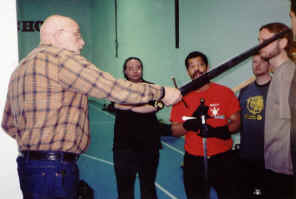 Hank: “One item I want to make clear on is
this old rumor that I did nothing to get Del Tin swords placed in the old Museum
Replica’s Limited catalogs, that it was all Fulvio. Hmmm, wonder why I did all that
traveling to England, Germany, Sweden, etc. and looked at all the museums, and why Museum
Replicas paid me to do it? I guess they liked my pretty face.” Hank: “One item I want to make clear on is
this old rumor that I did nothing to get Del Tin swords placed in the old Museum
Replica’s Limited catalogs, that it was all Fulvio. Hmmm, wonder why I did all that
traveling to England, Germany, Sweden, etc. and looked at all the museums, and why Museum
Replicas paid me to do it? I guess they liked my pretty face.”
“When we started with Del Tin there were three
brothers, and they were making a few swords. All of the swords were copied from swords in
the Stibbert Museum in Florence. When I first saw them they were being sold by a German
firm, but because all of the swords were from that museum, I figured out that the outfit
that made them was probably Italian. Flavio
was the eldest brother, and he was the one who knew, and liked swords. Fulvio was the
business head, and Maurizzo was the youngest. We put some of their swords in the MRL
catalog, and they made a lot of swords that I personally drafted up and sent them. After
about five years, there was a blowup, and Flavio and Maurizzo left. Then a couple of years
later, Fulvio made some swords on his own. We put some of them in the MRL catalog, but
usually they didn’t do very well. Fulvio didn’t understand the American market,
plus I think he kept getting his guards and pommels too large. Flavio knew swords pretty
well, and had kept them to the proper size.”
“After we sold the company to Windlass Steel
Crafts of India, I knew it was just a matter of time before Del Tin cut us off. I was in
Nuremberg when Fulvio asked Sudhir [of Wondlass Steelcrafts] to make blades for him, and
Sudhir refused. There was a bad move though when a MRL wholesale catalog was produced
using older photos of actual Del Tin swords, when they should have actually been of the new Windlass Blades. Our art department
screwed up badly on that, but since the wholesale operation was never launched, it really
didn’t make any difference. But then
Fulvio started to tell us how to run out catalog, and that was more than any of us would
stand.”
ARMA: So you originially selected then drafted the
dimensions and measurements for perhaps 80% of those sword models? Interesting.
HANK: “These are historical
blades sitting in museums, and like helms or armor or any weapon for that matter, anyone
is free to make their own reproduction versions of them.”
ARMA: Ok, well, anything else you would like to
talk about?
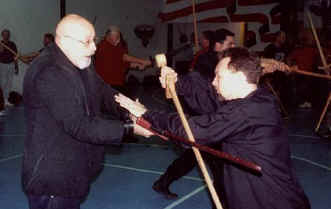 Hank: “Yes. On the Internet I have run across
comments about John Clements being a 'student' of mine. That simply isn’t true and
neither of us has ever claimed it. I’ve been in contact with John for a number of
years, and have furnished him with a lot of information, and we have shared a lot
information, but I have not really personally taught him anything regarding swordplay. He
considers me a mentor, but his work on the use of the sword and the manuscripts and
fighting manuals he did on his own. He does his own thing. We disagree on several things,
but we have never gotten into an argument. On many subjects our opinions have shifted, and
we get closer and closer to the same conclusions. This is the advantage of what I consider
‘reasoned discourse’. That’s what friends do.” Hank: “Yes. On the Internet I have run across
comments about John Clements being a 'student' of mine. That simply isn’t true and
neither of us has ever claimed it. I’ve been in contact with John for a number of
years, and have furnished him with a lot of information, and we have shared a lot
information, but I have not really personally taught him anything regarding swordplay. He
considers me a mentor, but his work on the use of the sword and the manuscripts and
fighting manuals he did on his own. He does his own thing. We disagree on several things,
but we have never gotten into an argument. On many subjects our opinions have shifted, and
we get closer and closer to the same conclusions. This is the advantage of what I consider
‘reasoned discourse’. That’s what friends do.”
“Let me
give you an example. One guy on the Internet tested a katana and claimed it was quite good
because he could break a concrete block with it. This was one of the dumbest reviews I
ever read. I can break a concrete block with a machete, a hammer, a baseball bat, and
doing so will damage none of them. It simply has nothing to do with being a good sword. It
was obvious that the reviewer had no idea of what constituted a good sword. But this guy
considers himself quite expert in the sword. I frankly hate hyperbole, and that is exactly
the kind of thing I see a great deal. A sword
should be tested to do what the sword is supposed to do. Since its illegal to go around
cutting people, then we have to develop different standards. But merely smashing a
concrete block isn’t one of them. A rapier for instance should be judged on how well
it’s made, the toughness of the steel in delivering a thrust or parry. Balance is
entirely subjective, but the balance point can be shown. Basically the same is true for
cutting swords, etc. But you need to know a little more about swords and what they are
supposed to do than I have seen by many of those reviewing swords on the Internet.”
ARMA: What do you think of some the new historical
sword groups and combat organizations that have gotten started on the Net?
 Hank: “Recently a friend of mine, Mike Stamm,
looked over the Internet at the various groups. Mike is a retired Michigan State
patrolman. In the terminology that I am familiar with, he has “seen the
elephant” and has “been the route”. His comment (of which I am very
jealous, it’s that good) sums it up perfectly. He
said, “Seems to me everyone [out there] is saying, ‘my pretend fighting is
better than your pretend fight’. He’s
right. In short, people do not fight with swords anymore. At least not when they can get
their hands on a firearm. If I had to go into combat today, I would grab a rifle, a kukri,
which is a very useful tool, and maybe a handgun. But above all I would take a rifle, and
not a sword. Hank: “Recently a friend of mine, Mike Stamm,
looked over the Internet at the various groups. Mike is a retired Michigan State
patrolman. In the terminology that I am familiar with, he has “seen the
elephant” and has “been the route”. His comment (of which I am very
jealous, it’s that good) sums it up perfectly. He
said, “Seems to me everyone [out there] is saying, ‘my pretend fighting is
better than your pretend fight’. He’s
right. In short, people do not fight with swords anymore. At least not when they can get
their hands on a firearm. If I had to go into combat today, I would grab a rifle, a kukri,
which is a very useful tool, and maybe a handgun. But above all I would take a rifle, and
not a sword.
“Let
me expand on this whole theme of historical combat for a moment. And I would like to start
with unarmed hand to hand combat. Many people
are amazed to find that the Western World had many of the moves that they see in the
Oriental Arts. This proves that they are not thinking clearly. The Human Body is quite
old, and at least since Cro-Magnon man we have been fighting each other. I have no doubt
that an effective form of wrestling was fully developed before man started to polish his
stone tools. Certainly the Greeks, the Egyptians, the Chinese, the Indians, etc., all had
fighting arts that were very similar to each other. So why is anyone surprised when they
encounter a wrestling manual from the 16th century? As for swords, I feel that every individual that
wrote a manual had at least a few students that practiced his techniques. Therefore, it
follows that every one of these manuals is an ‘accurate historical method’ of
swordplay. Please note that I did not say that they were effective, only that they
are historically correct.”
ARMA: So,
how effective do you think the historical styles were then?
Hank: “This is something that is quite difficult to
assess. First, I have not read all of them. I have seen some that had interesting and
effective moves, and many that I feel would get you killed. Second, we are looking at
these manuals from a great distance, and we are completely divorced from the historical
and cultural context in which they were written. Not only are we translating from one
language to another, but from one time to another and from one culture to another. Since
we can’t go back in time, we cannot say for sure what was the full intent for any of
the manuals or the moves they contain. At best, we can only extrapolate. Consider two
things. The manuals do not deal with combat in the course of a larger battle. They
can’t, as there are entirely too many variables. Also consider today’s world.
You can get a karate manual, then you go to the dojo, and its different. Then you enter a
full-contact match, and its even more different, and then you get into a street fight, and
its completely different than what you have been taught. The same is true with the manuals
then, and the manuals now.”
ARMA: “Do you study much of the Medieval and
Renaissance fencing manuals yourself?
Hank:
Only a little. I am more interested in the best possible use of the weapon, and not just
in how a certain individual used it. I have no doubt that some of the individuals writing
were probably competent and had “seen the elephant”. I am just as sure that some
of them had never been in a serious fight.”
ARMA: Interesting.
You alluded to the perceived conflicts among some of the various groups and
individuals pursuing this subject, do you have any comment on that, or what to do about
it?
Hank:
“Well, yes. What I would like to see is most of this nonsense and bickering put
aside. Stage combat, sport fencing, the various Medieval groups, they can believe what
they want. The important thing is to form an association that will help maintain an
interest in weapons and weapon play. Most people don’t know that back in 1984 for
instance, Senator Kennedy tried to pass a law that would have banned all martial arts
weapons, including swords, tomahawks, bowie knives, etc. People don’t know that if my
friend Bill Adams, (of Atlanta Cutlery) hadn’t jumped in to organize a grass roots
lobby campaign against it, probably no one in this country would be allowed to own a
decent replica sword today. Bill was able to
get the legislation stopped early. But such a thing will come up again, and the sword
fraternity needs to be ready for it. The
Asian martial arts community has finally adopted some mixed martial arts tournaments.
Organizations interested in historical could should do the same thing. At one time I
thought they would. I think it certainly would put to rest all of the questions about who
and what is the best.”
ARMA: Assuming
the rules were broad and all-encompassing enough, sure.
ARMA:
Have you ever thought about trying to do some of this yourself?
Hank: “I thought about it. Then quite quickly put
it out of my mind. I’m too old, too lazy and with too many others things to do to go
try and start a new effort like that. It would be a lot of hard work, and rather a
thankless task at best. What I might be interested in doing is starting a new forum for
those who are seriously interested in swords and history. I don’t think you
can divorce swordplay from history, and a lot of people ignore the historical context of
the various forms of swordplay.”
ARMA: Yes, they sure do. ARMA is trying to work on
that problem now, as well as raising the credibility and legitimacy of this subject.
ARMA: So
then, what are your plans for the future, you have some special projects we understand?
Hank: “I’m hoping to finish my book. I have
plans for a third video on the cutting power of various swords and weapons, and also how
to cut effectively. I’m also considering teaching some sword and shield techniques in
the near future. I’m also trying to come up with more effective sparring weapon
designs. But being old and lazy, I’m not making any definite plans right now.”
ARMA: Yes, it will take a lot more effort at
education to teach these things. In the mean
time, since the Internet tends to serve the lowest common denominator we are likely to see
a continuation of pettiness. We will have to
work against that by setting a better example. Okay, as always, thanks for the comments!
Back
to Spotlight |

